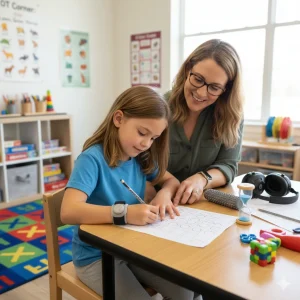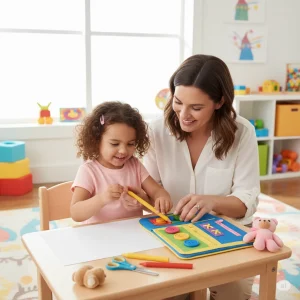Can Echolalia Be Treated? Speech Therapy Insights for Parent
By Rajini D
Last Updated: June 19, 2025
What if your child’s repeated words aren’t just mimicry—but a powerful step toward communication?
If your child often repeats words or phrases they’ve just heard—sometimes hours or days later—you might be witnessing echolalia, a common behavior in children with autism. While it may seem confusing, echolalia is more than just repetition—it can be an early step toward communication. The good news? With the right echolalia treatment, especially through online speech therapy for autism, many children can develop meaningful ways to express themselves.
Help Your Child Speak Better
Support your child’s speech, language, and confidence with personalized online therapy—fun, expert-led, and from home.
The Impact of Echolalia on Communication
Understanding how echolalia affects communication is key to supporting individuals who use this behavior. Echolalia isn’t just mimicry—it often acts as a bridge to meaningful communication. Children and adults on the autism spectrum may repeat phrases to keep a conversation going or to buy time as they process what someone said.
However, echolalia can create challenges in social situations. It may lead to misunderstandings or frustration, especially when others don’t know how to respond. For example, when a child with autism repeats a question instead of answering it, people might assume they aren’t listening or don’t understand. In reality, the child could be using repetition as a genuine effort to engage.
Speech therapists develop techniques that turn echolalia into purposeful communication. They identify each individual’s triggers and communication patterns, then apply targeted strategies to help shift from repetition to more spontaneous and creative language use.
Comprehensive Treatment Approaches for Echolalia
Speech Therapy: First Line of Treatment for Echolalia
When it comes to treating echolalia, speech therapy is often the first and most crucial step. Speech therapists utilize a variety of techniques designed to help individuals use language more effectively and transition from echolalic repetition to spontaneous and functional communication. This process involves identifying the purpose behind the echolalic behavior and guiding the individual toward more meaningful exchanges.
One effective method used in speech therapy is the use of prompts and cues to encourage independent speech. For example, if a person tends to repeat questions instead of answering them, a therapist might gradually fade their prompts, encouraging the person to respond on their own. Over time, this can help decrease reliance on echolalia as the main form of communication.
At Wellness Hub, our therapists are trained to create a supportive and understanding environment. We focus on building a relationship where individuals feel comfortable experimenting with language and expressing themselves uniquely and effectively.
For a deeper look at why echolalia occurs and how to support your child, explore our guide on understanding echolalia in autism.
Behavioral and Cognitive Interventions: Enhancing Communication Skills
Behavioral and cognitive interventions play a significant role in managing echolalia. These approaches are not just about reducing repetitions; they’re about understanding and reshaping the way an individual interacts with their environment. Cognitive-behavioral therapy , for instance, helps individuals understand the context of their echolalia and develop alternative strategies for communication.
Behavioral strategies might include positive reinforcement for using novel phrases, or structured social interaction sessions that simulate real-life scenarios. These methods help individuals with echolalia learn not just how to communicate, but how to do so in a way that is both socially appropriate and personally satisfying.
Integrative Approaches: Combining Techniques for Optimal Outcomes
Integrative approaches to echolalia treatment involve a combination of various therapies and techniques to address the multifaceted nature of echolalia. This might include a mix of speech therapy, cognitive-behavioral strategies, and other supportive therapies like occupational therapy or sensory integration therapy, depending on the individual’s needs.
The idea is to not only improve language skills but also to enhance overall cognitive function and sensory processing abilities, which are often underlying factors in echolalic behavior. For example, using rhythm and music therapy can help in regulating speech patterns and improving verbal memory, which in turn can reduce the reliance on echolalia.
Role of Speech Therapists in Treating Echolalia
Techniques Used by Speech Therapists to Reduce Echolalia
Speech therapists play a pivotal role in treating echolalia, employing various techniques tailored to each individual’s needs to help them move towards more meaningful and independent communication. The goal isn’t just to reduce echolalia but to enhance overall communication skills, allowing individuals to express their thoughts, needs, and emotions more effectively. Here are some key techniques used by speech therapists:
- Modeling Language: Speech therapists often use modeling as a technique where they slowly and clearly speak the desired phrases during therapy sessions. By consistently modeling proper language use, individuals are encouraged to imitate these models over their echolalic phrases, gradually learning to initiate communication without echoes.
- Expansion and Extension: This technique involves taking an echolalic phrase that the individual has just used and expanding on it to make it more meaningful. For example, if a child repeats the question, “Do you want cookies?”, the therapist might expand it to, “Yes, I want cookies because they are tasty.” This helps the individual understand context and the use of language in communication.
- Prompting and Fading: Speech therapists use prompts to guide the correct response and gradually fade these prompts as the individual begins to respond independently. This method encourages self-initiated communication and reduces reliance on echolalic responses.
- Use of Visuals and Sign Language: Incorporating visual aids, such as pictures or sign language, can help bridge the gap between echolalia and functional communication. Visuals provide a concrete representation of words and phrases, making it easier for individuals to understand and use language appropriately.
- Delayed Auditory Feedback (DAF): Some therapists use DAF devices that delay the heard speech slightly, which can disrupt the echolalia pattern and encourage the individual to listen more attentively to their speech, reducing immediate repetition.
Start Your Journey to Better Communication
Echolalia can be effectively managed with the right support. At Wellness Hub, we utilize proven speech therapy and cognitive techniques to transform echolalia into meaningful communication. Starting your treatment is simple: Visit our speech therapy services page to discover how we can help, book a consultation online to develop a personalized treatment plan, and receive tailored support using therapy tools for improving communication as you see real improvements. Join us at Wellness Hub and begin improving communication today. Let’s make every word count together! Visit our website to get started or learn more.
Frequently Asked Questions:
1. What is echolalia and why does it happen?
Echolalia is the repetition of phrases or sounds that a person hears, common among individuals with autism. It’s a natural part of language development for some, helping them process spoken language and learn to communicate. Echolalia can be immediate (repeating something right away) or delayed (repeating it later).
2. Can echolalia be treated?
Yes, echolalia can be effectively managed with appropriate interventions. Speech therapy is particularly beneficial, focusing on improving communication skills and reducing the reliance on repeated phrases.
3. What are the first steps in treating echolalia?
The initial step in treating echolalia involves consulting with a speech therapist who can assess the individual’s specific needs. The therapist will design a personalized treatment plan that may include various speech exercises and cognitive-behavioral techniques.
4. How can speech therapy help reduce echolalia?
Speech therapists use several techniques such as modeling correct language use, expanding on echoed phrases to make them more meaningful, and teaching prompts that encourage independent speech. These strategies help individuals understand and use language in more appropriate and functional ways.
5. Are there any home exercises I can do to help with echolalia?
Yes, parents can support their child at home by engaging in activities that promote language development. This includes reading together, using flashcards to build vocabulary, playing turn-taking games to improve conversation skills, and reinforcing the use of language learned during therapy sessions.
6. What role do parents play in managing echolalia?
Parents are crucial in reinforcing the strategies learned in therapy. By providing a consistent and supportive environment, practicing communication skills daily, and using positive reinforcement, parents can help their child make significant progress in overcoming echolalia.
7. How long does it take to see improvement in echolalia?
The time it takes to see improvement can vary greatly depending on the individual and the consistency of therapy and home practice. Some families notice improvements within a few months, while others may see gradual progress over a longer period.
8. Can echolalia return after it has been treated?
Echolalia may reoccur, especially during periods of stress, transition, or illness. Continuous support and maintaining a routine can help manage these flare-ups. Periodic follow-up sessions with a speech therapist may also be necessary to reinforce skills.
9. What other types of support are effective for echolalia?
Alongside speech therapy, cognitive behavioral therapy (CBT) and other behavioral interventions can be effective. These therapies help understand the context of echolalia and teach alternative communication strategies. Additionally, occupational therapy might be recommended to address sensory processing issues that can accompany echolalia.
10. How can I get started with echolalia treatment at Wellness Hub?
To begin treatment for echolalia at Wellness Hub, visit our speech therapy services page to find out more about our approach and schedule an initial consultation. Our team will work with you to assess your needs and create a tailored treatment plan focused on effective communication skills and reducing reliance on echolalia.
About the Author:
Shravanaveena Gajula
M.Sc ., Speech and Language Pathology (5+ years of experience)
Shravanaveena Gajula is a dedicated Audiologist and Speech-Language Pathologist with a BASLP and an M.Sc in Speech and Language Pathology. With experience spanning multiple settings, including Wellness Hub and Ashray Akruti, Veena specializes in a wide range of disorders from developmental issues in children to speech and language assessments in adults. Her expertise includes parent counseling, managing speech sound and fluency disorders, and creating individualized therapy programs. Veena is also PROMPT certified and an author of several insightful blogs on speech and language pathology, aiming to educate and assist caregivers in supporting their loved ones.
Book your Free Consultation Today
Parent/Caregiver Info:
Client’s Details:
* Error Message









